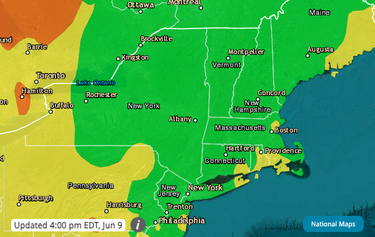Local air quality improves as winds blow west
ALBANY COUNTY — By Friday at 4 p.m., the vast majority of New York State, including Albany County, had what the Environmental Protection Agency terms “good” air quality.
A bit of western New York, in the Buffalo area, and the tip of Long Island had “moderate” quality, where, the EPA advises “a very small number of people who are unusually sensitive to air pollution” may have concerns.
For the same time frame, the state’s system showed just the Adirondacks with “good” air quality, western New York with “air unhealthy for sensitive groups” and the rest of the state as “moderate.”
At the same time, Quebec’s fire prevention agency, Société de protection des forêts contre le feu, reported 125 active wildfires.
“For more than a week, we have been sounding the alarm that air quality issues are serious and pose a threat to the health and well-being of New Yorkers,” Governor Kathy Hochul said in a noon release on Friday. “Now, as conditions gradually improve and it becomes safer to be outdoors in many regions of the state, it’s critical that New Yorkers continue to stay informed and take common-sense safety precautions to protect themselves and their families.”
The state’s health department has an Electronic Syndromic Surveillance System, which reported 147 asthma-related emergency-department visits to New York hospitals, not including New York City, on June 7, compared to an average of 80 for the five-day period June 1 through June 6.
Using data reported for “respiratory symptoms” on June 8 from Emergency Medical Services response data, which is a timely early-warning source, the health department observed a statewide increase of 17.8 percent in the rates per 100,000 on Wednesday, June 7, as compared to the average of the five-day period of June 1 through 5.
At the same time, for the metropolitan New York City region, the increase was 28.4 percent and for the Capital Region, it was 12.4 percent.
The air flow is expected to continue to send the heaviest smoke south and west of New York, the Friday release said, with the southerly and western regions of the state continuing to see smoke conditions. The forecast for Saturday shows winds turning to a more north-northwesterly direction, with the possibility some smoke could come into the state late Saturday.
The state’s departments of health and environmental conservation issue advisories when DEC meteorologists predict levels of pollution, either ozone or fine particulate matter, are expected to exceed an Air Quality Index value of 100. The AQI was created as an easy way to correlate levels of different pollutants to one scale, with a higher AQI value indicating a greater health concern.
The state’s health department encourages New Yorkers to check on the air quality in their region and take these steps to reduce risk:
— When AQI is greater than 100, New Yorkers in vulnerable groups should avoid exertion outdoors and watch for symptoms when exposed to the outdoors. Vulnerable individuals include those with cardiovascular disease, such as congestive heart failure or a history of prior heart attack, or lung disease, such as asthma, or chronic obstructive pulmonary disease, as well as children under 18, and adults 65 and older;
— When AQI is greater than 150, all New Yorkers should avoid strenuous outdoor activities, and those in vulnerable groups should avoid exposure to the outdoors; and
— Individuals who are pregnant may also be more vulnerable and become short of breath more easily; staying indoors when AQI is greater than 150 is advised.
The health department also advises that any New Yorker who experiences symptoms or has symptoms that worsen, including those indicative of complications from heart disease or a heart condition, should consult their personal physician or seek immediate medical help. If experiencing symptoms of respiratory irritation while outside, like coughing, first go inside to find cleaner air, the department says.
“While conditions are improving overall across the state, we continue to remind people, especially those vulnerable to health impacts from unhealthy air quality, to self-monitor for symptoms and to stay inside if the air quality in their area is deemed unhealthy …,” said Acting State Health Commissioner James McDonald in the Friday release. “If vulnerable individuals must go outdoors during poor air quality conditions, they are encouraged to use a high-quality, well-fitting mask.”
Also on Friday, Hochul announced full refunds to those who made reservations to visit a DEC or Office of State Parks, Recreation and Historic Preservation campgrounds or day-use area and want to cancel due to air quality concerns.
Visitors who wish to cancel on the day of arrival should call their campground directly. Visitors who wish to cancel prior to their day of arrival should call the ReserveAmerica Customer Service at 1-800-777-9644. New York State campgrounds remain open, and all reservations will be honored for those who chose to camp this weekend.
Hochul announced on Thursday that a team of seven DEC forest rangers is deploying to assist with efforts to help contain the wildfires. They will head to Quebec to lead a 15-person team of expert wildland firefighters from Maine, New Hampshire, and Vermont for the next two weeks, and are in addition to a DEC Forest Ranger currently leading firefighting efforts in Nova Scotia.


